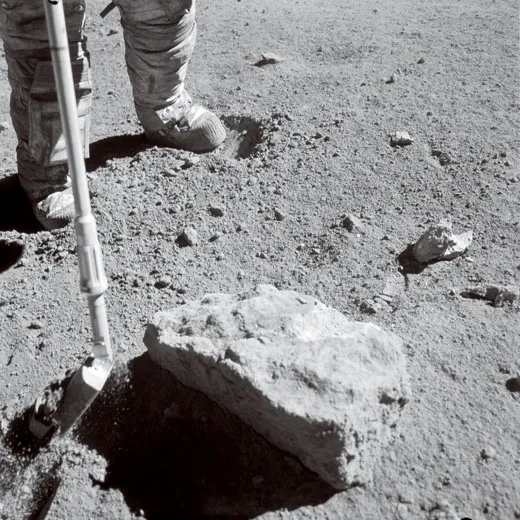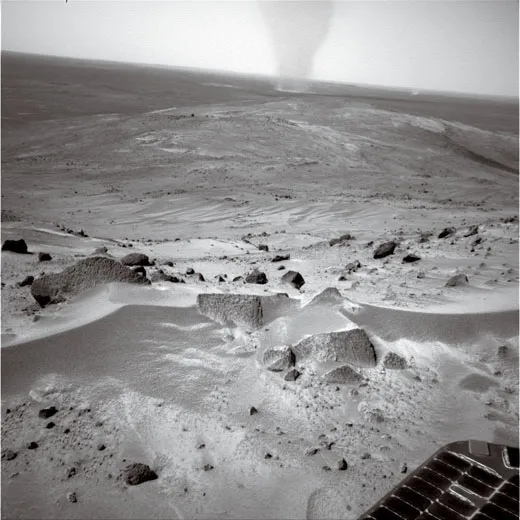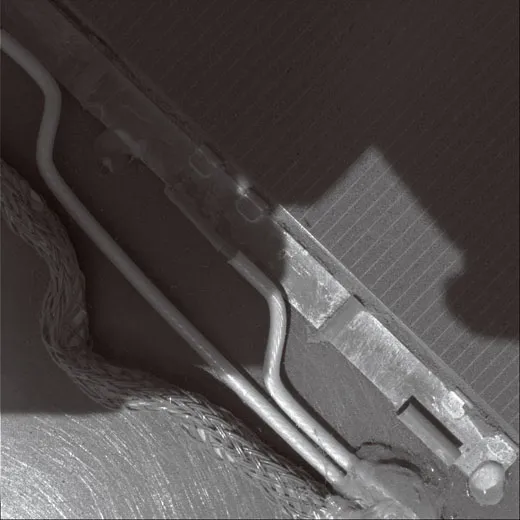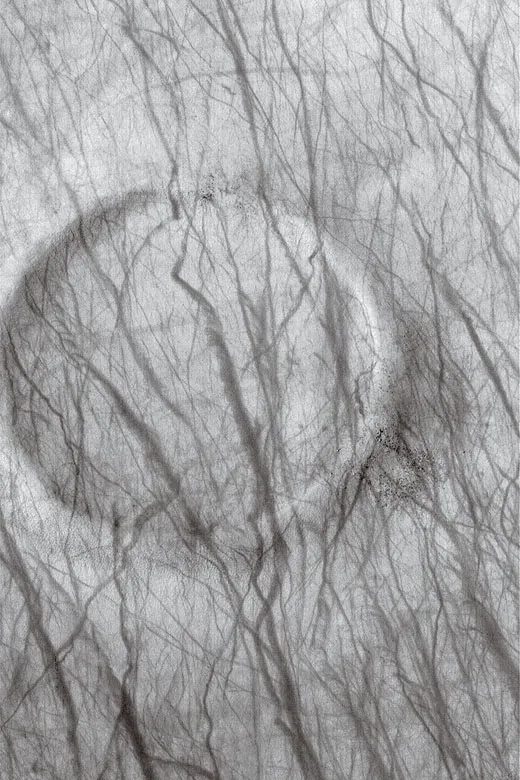Stronger Than Dirt
Lunar explorers will have to battle an insidious enemy—dust.
/https://tf-cmsv2-smithsonianmag-media.s3.amazonaws.com/filer/dirt-388-sept06.jpg)
ANOTHER LUNAR DAWN, and the powdery dust on the moon’s surface begins to stir. Without a breath of wind, the finest motes swirl across the ancient landscape as electrostatically charged dust grains repel one another. Larger grains join the dance in a line that stretches more than 3,000 miles from the lunar north pole to the south pole, along the edge of advancing daylight.
Within hours the dance has become frenzied and vertical, with microscopic grains hurtling miles overhead, the tiniest ones flying the farthest, until the weak lunar gravity stops their rise and pulls them back to the dusty surface. Instead of resting there, many jump up to begin the dance anew, surrounding the moon with a veritable atmosphere of dust—glassy, abrasive, toxic grit that could spell “No Trespassing” to future explorers.
Under a cloudless blue Colorado sky, I accompanied seven scientists, a graduate student, and an education specialist as they toiled up the shifting sands of the tallest dunes in North America. At 8,200 feet above sea level, the intense sunlight scorched our skin even though it was October, and in the thin air, the exertion left us panting. The incessant wind quickly smoothed away our footprints. We were in the Great Sand Dunes National Park and Preserve, but it felt as though we were alone on Mars.
And that was the idea.
We were there to study the problems awaiting NASA engineers planning the next generation of lunar outposts and Mars expeditions. Four of the scientists carried miniature Mars rovers that looked like the kind of radio-controlled toy you might find at RadioShack. They had thought about bringing NASA’s one spare of the Sojourner rover from the 1997 Mars Pathfinder expedition, “but the commercial truck chassis were far cheaper,” explained team leader Masami Nakagawa, an associate professor of mining engineering at the Colorado School of Mines in Golden. Each of the model trucks had been modified for this expedition: transmissions geared down, engines souped up, the body of one turned into a rotating auger for digging in the sand.
For two eight-hour days under the broiling sun, scarcely breaking for granola bars or water, the scientists took turns at the radio controls to put the rovers through their paces. The vehicles were sent climbing the steep dunes until half-buried by avalanches, while cameras and a crude duct-tape tape measure (the real thing had disappeared in the soft sand) documented their progress, or lack thereof. “Hey, I think sand and dust finally jammed the transmission!” exulted grad student Jared Reese, holding aloft the auger vehicle, which had finally refused to budge, even with a freshly charged battery.
Celebrating when the equipment stops working? That was in fact the purpose of this NASA-sponsored “Dust-Off”: to court Murphy’s Law. “Over the next two days, our interdisciplinary team can get a direct feel for how invasive dust is,” explained Nakagawa over the first night’s dinner, at the Great Sand Dunes Oasis restaurant. “We want to look at lunar and Martian dust mitigation from a systems engineering viewpoint.”
By “dust,” Nakagawa doesn’t mean house dust. Most of the stuff that collects on furniture is actually organic material like dead human skin cells, pet dander, and pollen grains. For the most part, it’s soft: Wipe it off with a cloth and it won’t scratch polished wood. And it’s usually not thick. Even an attic corner that hasn’t been swept in years can accumulate less than an eighth of an inch.
On Earth, the closest equivalents to lunar and Martian dust are the choking storms that sometimes blow west from the Gobi Desert to blanket Beijing with millions of tons of ultrafine particles. In 1980 powdery volcanic ash fell an inch deep hundreds of miles from Washington’s Mount St. Helens, and “white outs” of alkali gypsum dust swept the Nevada playa just after the 2002 Burning Man arts festival. But even these aren’t good analogs. In terrestrial deserts the atmosphere is too dense, the soils too humid, the plants too numerous, and the weathering from wind and water too prevalent to match conditions on the moon or Mars.
Lunar dust is razor-sharp grit made of inorganic stone and powdered glass. It was formed over hundreds of millions of years by micrometeorites slamming into the moon at high velocities, fracturing lunar rocks into shards and melting the sand into glass. The Apollo astronauts who trod the inches-deep regolith (the preferred term for extraterrestrial dirt) discovered what a nuisance it could be. Wipe a spacesuit’s sun visor, and it scratched the protective layer of gold. Get dust into the spacesuit’s joints, and it fouled the attachments and seals. Try to brush the grit off a spacesuit before reentering the lunar lander, and its sharp edges dug into the fabric. Track it inside the habitat, and it became airborne. Breathe it in and mucous membranes swelled shut (“I didn’t know I had lunar dust hay fever,” commented Apollo 17 geologist-astronaut Jack Schmitt at the time). Go back out, and the graphite-black dust had so darkened the white spacesuits (“Looks like you guys have been playing in a coal bin,” quipped mission control during the Apollo 16 mission) that the fabric absorbed rather than reflected the murderous sunlight, overheating the astronauts’ life support systems.
And that’s just the moon.
On Mars, the dust may be corrosive and poisonous too. Martian soil is expected to be a strong oxidizer (think of powdered bleach or lye) laced with heavy metals such as hexavalent chromium, the carcinogen in the movie Erin Brockovich. It’s also, as engineers operating NASA’s Mars rovers have learned, magnetic. Photographs taken by Spirit and Opportunity show Martian dirt, reddish with oxides of iron, coating magnets on the vehicles. On the moon, glass in the regolith is filled with microscopic beads of pure iron—so-called nanophase iron. In both places the dirt is likely to stick to anything with an electromagnet, including motors and electronics.
A mere two days in the Colorado dunes was enough to convince me of the insidious mechanical challenges that dust will present to future astronauts and their machines. The windborne grit scoured our skin raw, sifted into hair and zippers and shoes, messed up the transmissions of all four rovers, and jammed the buttons of cellular phones.
Even on the airless moon, the dirt doesn’t lie still. Astronauts in lunar orbit aboard the Apollo 8, 10, 15, and 17 spacecraft repeatedly observed and sketched what they variously called “bands,” “streamers,” or “twilight rays” for about 10 seconds before lunar sunrise or sunset. The drawings are reminiscent of the slanting rays that filter up through clouds during sunsets on Earth. Some scientists chalked the phenomenon up to light reflecting from dust suspended above the lunar surface, but others remained unconvinced: Without an atmosphere, how could dust be suspended above the moon? Even if the particles were kicked up by, say, a meteorite impact, they would quickly settle back to the surface.
It wasn’t until last year that Timothy Stubbs and his colleagues at NASA’s Goddard Space Flight Center in Greenbelt, Maryland, came up with an explanation, which they called the “dynamic fountain” model. In a drinking fountain, the arc of water from the spout appears suspended in one position, but the water molecules are constantly in motion. Similarly, according to Stubbs, microscopic grains of lunar dust are constantly leaping from the surface and falling back again due to a weird phenomenon unknown on Earth: electrostatic lofting.
Just as rubbing a balloon against your shirt creates a static charge that can levitate the hair on your head, lunar dust particles with opposite charges will attract each other, and like-charged particles will repel. How does the dust become charged? On the moon’s sunlit side, solar ultraviolet and X-ray radiation beats down relentlessly, knocking electrons from atoms in the lunar soil. The electrons escape into space, and positive charges build up on the lunar surface. The tiniest motes of dust—just a few hundred-thousandths of an inch in size—are repelled from the rest and launched upward, some reaching miles above the surface. Lunar gravity eventually pulls them back down, but electrostatic repulsion kicks them off again. The process is repeated over and over to form a tenuous “atmosphere” of moving dust particles.
The same happens on the lunar far side, which is bombarded by solar wind particles flowing around the moon—except that the net charge is negative since the solar wind is mostly electrons. Data from the 1998 Lunar Prospector mission suggests that the electrical potential might amount to hundreds of volts on the night side, even higher than on the day side, possibly launching dust particles to higher velocities and altitudes.
Evidence supporting the dynamic fountain model may be buried in old data from the Lunar Ejecta and Meteorites experiment, left on the moon by Apollo 17 in 1972. LEAM had three sensors that could record the speed, energy, and direction of tiny particles. The experiment was designed to look for fallout from lunar meteorite impacts, as well as material raining down from comets or interstellar space. But in a classic case of serendipity, “LEAM recorded a high number of particles every lunar sunrise,” recounts Gary Olhoeft, professor of geophysics at the Colorado School of Mines, “mostly from east or west rather than from above, and mostly much slower than expected.” Even stranger, a few hours after every lunar sunrise, LEAM’s temperature rocketed up so high—near that of boiling water—that the instrument had to be turned off because it was overheating. Olhoeft and others now suspect that dust lofted from the moon covered the LEAM, darkening its surface so the experiment package absorbed sunlight rather than reflected it. But nobody knows for sure. LEAM operated only briefly before the Apollo program ended.
Then there are the puzzling rays seen by the Apollo astronauts. Because the specks of dust bouncing around on the moon would be too small to see with the naked eye, explorers on the surface wouldn’t likely notice them. But astronauts on the night side around sunrise might see the moving dust causing the sunlight to scatter, looking like “a weird, shifting glow extending along the horizon, almost like a dancing curtain of light,” according to Stubbs. And at certain times during the lunar cycle, when the moon passes through an active part of Earth’s magnetosphere, Stubbs speculates that “dust would start flying at high velocities”—not at densities that could be seen from Earth, but perhaps in large enough amounts to get into unprotected machinery on the moon.
Last year, in a 77-page report listing 20 risks that required further study before we should commit to a human Mars expedition, NASA’s Mars Exploration Program Analysis Group ranked dust number one. The report urged study of its mechanical properties, corrosiveness, grittiness, and effect on electrical systems. Most scientists think the only way to answer the questions definitively is by returning samples of Martian soil and rock to Earth well before launching any astronauts.
Many also believe a lunar sample return will be necessary. True, the Apollo astronauts brought back some 800 pounds of lunar rocks from six landing sites. But the dust played a dirty trick: The gritty particles deteriorated the knife-edge indium seals of the bottles that were intended to isolate the rocks in a lunar-like vacuum. Air has slowly leaked in over the past 35 years. “Every sample brought back from the moon has been contaminated by Earth’s air and humidity,” Olhoeft says. The dust has acquired a patina of rust, and, as a result of bonding with terrestrial water and oxygen molecules, its chemical reactivity is long gone. The chemical and electrostatic properties of the soil no longer match what future astronauts will encounter on the moon.
To better understand lunar dust, Olhoeft is trying to undo the damage. During the Apollo program six steel vacuum chambers were built, each 10 feet long, that could be pumped down to 10-12 torr—one- trillionth the atmospheric pressure of sea level on Earth—to duplicate the vacuum on the moon. After the Apollo program shut down, five of the giant tanks were scrapped. The remaining chamber, recently refurbished, is in Olhoeft’s laboratory at the Colorado School of Mines. He plans to insert a sample of real lunar dust, pump the pressure down to lunar vacuum, cycle the chamber’s temperature to duplicate the harsh lunar day and night, and bombard the contents with radiation and electrons to try to resuscitate some of its original properties.
At NASA’s Marshall Space Flight Center in Huntsville, Alabama, in a smaller basketball-size vacuum chamber located inside the Dusty Plasma Laboratory, researcher Mian Abbas is running a positively Zen-like experiment. Each morning, he enters the lab and sits down to examine a single speck of lunar dust. For as long as 10 or 12 days at a stretch, he shines an ultraviolet laser onto the particle and painstakingly controls the strength of electric fields until the speck levitates. “Experiments on single grains are helping us understand how lunar dust on the moon can be given an electric charge and lofted to high altitudes,” Abbas explains.
Olhoeft, Stubbs, and others are also mining original Apollo data, such as that from LEAM, in the hope that the unread tapes might yield information useful in designing lunar spacesuits and equipment. It’s easier said than done: Many original computer tapes from Apollo experiments, including ones that were never analyzed, can no longer be read. Not only are some of the data formats obsolete, many of the tapes have degraded due to less-than-optimum storage. Some of the data may be permanently lost. So the dust researchers do what they can. They pore over frame after frame of footage taken by the Apollo astronauts, measuring the trajectory of dust particles kicked up by boots and rover wheels, hoping to better understand the physics. Others, like Bruce Damer of Digital Space in Santa Cruz, California, are building computer models of the dust so that design engineers can test-drive hypothetical digging machines and see what gets clogged.
While these scientists study the dust itself, engineers are coming up with prototype systems for combating it. At the Kennedy Space Center in Cape Canaveral, Florida, Carlos Calle and colleagues in the Electrostatics and Surface Physics Laboratory have demonstrated a device they think can be embedded in spacesuit fabrics to create oscillating electric fields. The rapid shifting of the fields would cause dust particles to hop from electrode to electrode until they get thrown off the suit altogether. An even more imaginative dust-busting concept comes from Lawrence Taylor, a planetary scientist at the University of Tennessee at Knoxville, who describes himself as “one of those weird people who like to stick things in kitchen microwave ovens to see what happens.” When he tried it with a small pile of lunar soil, he found that it melted “lickety split”—within 30 seconds—at only 250 watts of power. The nanophase iron in the dirt concentrated the microwave energy to sinter, or fuse, the loose soil into large clumps. Taylor’s experiment has inspired him to propose machinery for turning bothersome lunar dust into useful solids: rocket landing pads, bricks for habitats, radiation shielding, even roads and radio antenna dishes.
That’s the other thing about dust: It isn’t always bad. On Mars, dust might actually help clean up its own mess. The solar panels on the twin rovers currently on Mars were expected to have been coated long ago with dust that would degrade their power output and bring the mission to a halt. More than once, though, tornado-like dust devils have scoured the panels clean and given the rovers new life.
But that’s the rare bit of good news. Dust storms on Mars will be a serious, continual worry. During Martian summer, daytime highs peak at 68 degrees Fahrenheit, and on these balmy afternoons the planet’s dust devils come alive. These are no little Arizona desert whirlwinds, a few yards across, that pass by in seconds. Martian dust devils are monster columns reaching miles into the sky and nearly half a mile across, 10 times larger than any tornado on Earth. When they pass by, the reddish sand and dust whips around faster than 70 mph, dropping the local visibility to zero for minutes at a time. And they’re everywhere. The Mars rover cameras have filmed them in action, and orbiting spacecraft have spotted their dark tracks all over the planet. “If you were standing next to the Spirit rover midday during Martian summer, you’d see half a dozen [dust devils] at any instant,” says Mark Lemmon, a Mars atmosphere specialist at Texas A & M University in College Station.
The sand in the lower part of a Martian dust devil would be a major hazard. Because the atmospheric pressure on Mars is only one percent of that at sea level on Earth, astronauts won’t feel much wind. But their spacesuits and faceplates would be pinged by high-speed material that would collect in every fold and crevice. Worse, the swirling dust and sand may be electrically charged, to the point of “possibly inducing arcing to a spacesuit or vehicle, and creating electromagnetic interference,” according to William Farrell, one of Stubbs’ colleagues at NASA’s Goddard center.
Farrell has chased dust devils across Arizona deserts and measured their electrical currents. Like levitating lunar dust, the grains of sand and dust become charged as a result of constantly banging into one another. On Mars as well as on Earth, the dust, which can blow in from anywhere, may be quite different from the local sand. When unlike materials rub together (like party balloon and shirt sleeve), one material gives up some of its electrons to the other in what’s known as triboelectric charging (“tribo” means “rubbing”). The smaller dust particles tend to take on a negative charge, having robbed electrons from the larger sand grains.
Triboelectric charging is known to occur on Mars. It came to the attention of NASA engineers building the Sojourner rover for the Mars Pathfinder even before the spacecraft left Earth. When the engineers ran the wheels for a prototype Sojourner over simulated Martian dust in a simulated Martian atmosphere, the model built up a charge of hundreds of volts. That discovery inspired the scientists to add ultrathin half-inch-long tungsten needles at the base of the rover’s radio antennas, to drain any excess charge into the thin Martian air.
Dust devils could even lead to lightning on Mars. All dust devils are powered by a rising central column of hot air, which carries the negatively charged dust upward and leaves the heavier, positively charged sand swirling near the base. The charges become separated, and the separation creates an electric field. In terrestrial dust devils, Farrell has measured electric fields of up to 20,000 volts per meter—peanuts compared to the fields in thunderstorms, where lightning doesn’t flash until the fields become 100 times stronger, enough to break apart air molecules. But 20,000 volts per meter “is very close to the breakdown of the thin Martian atmosphere,” Farrell points out. And because Martian dust devils are so tall, their stored electrical energy can be greater, possibly strong enough to unleash lightning.
Even if lightning doesn’t occur on Mars, the presence of an astronaut or rover might induce local arcing. “You’d have to watch out for corners, where electric fields can get very strong,” Farrell muses. “You might want to make a vehicle or habitat rounded.” And though dust devils can clean off solar panels, astronauts may still find charged dust clinging electrostatically to spacesuits, vehicles, and habitats.
None of these concerns is especially troubling to Apollo 17 astronaut Schmitt. He agrees that dust will be a nuisance for future lunar explorers. But he also expects that engineers will come up with practical solutions like an airlock—which is already being considered for the next-generation lander—that would let astronauts stow their dirty spacesuits before re-entering their living quarters after a moonwalk. “For scientific reasons, the dust is intriguing,” Schmitt says. “It’s a number-one engineering design problem for long-term habitation and settlement [of the moon]. But you protect yourself with a layered defense. The dust is not a problem that should scare us out of going back.”




